#humphry davy
Text
שאיפת גז צחוק
שאיפת גז צחוק הוא שיר שכתב הכימאי האנגלי האמפרי דייווי (1778-1828). בנוסף לכך שגילה מספר יסודות כימיים, עסק בהשפעה גז הצחוק על האדם. לאחרונה התגלה שכתב במחברות הניסויים שלו שירים רבים. האמפרי פרסם רק מעט שירים בחייו, ויש יאמרו שטוב שכך. השיר "שאיפת גז צחוק" עוסק בחוויה ופחות בריאקציות כימיות. התרגום מופיע מתחת לשיר המקורי.י
On breathing the Nitrous Oxide
Not in the ideal dreams of wild desire
Have I beheld a rapture wakening form
My bosom burns with no unhallowed fire
Yet is my cheek with rosy blushes warm
Yet are my eyes with sparkling lustre filled
Yet is my mouth implete with murmuring sound
Yet are my limbs with inward transports thrill'd
And clad with new born mightiness round –
שאיפת גז צחוק
אף לא בחלומות טרופי תשוקה
הייתה להתגלות כזו מקום
ליבי בוער באש ברוכה
ועוד לחיי אודמות מחום
ועוד עיניי ניצוץ בורקות
ופי חוזר על הברה נחטפת
ועוד ידיי מתוך תוכי רועדות
ועוצמה חדשה אותי עוטפת
2 notes
·
View notes
Photo

For the International Day of Light, we invite you to reflect (pun intended) on this charming juvenile biography of the scientist Sir Humphry Davy (1778-1829).
Sir Humphry Davy was a Cornish chemist and inventor with quite the record of scientific achievement:
Developed electrolysis (the process of using electricity to isolate elements)
Discovered the elements barium, boron, calcium, magnesium, potassium, and sodium as well as the compounds hydrogen telluride and hydrogen phosphide
Studied and wrote about the anesthetic effects of nitrous oxide (aka “laughing gas,” a term he also coined)
Proved that diamonds are made of carbon
Served as president of the British Royal Society; inaugural chairman of the Athenaeum Club; and co-founder of the Zoological Society of London
Davy was such a formidable player in the European realm of scientific learning that despite the fact that England and France were at war at the time, Napoleon gave the Englishman special permission to visit France’s leading scientists and have an audience with Empress Marie Louise in 1813.

So what, you may ask, does Sir Humphry Davy have to do with light? In the foregoing summary of the scientist’s life, we have left out his most famous accomplishment: the Davy safety lamp.

Naturally, coal miners working in the dark depths of the earth need artificial lighting by which to do their work. The problem was in early nineteenth-century northern England, the flame of the miners’ candles kept mixing with a natural flammable gas found in the mines, known as “firedamp,” causing a series of devastating explosions that claimed the lives of hundreds of miners. Moved by the suffering of working-class families in northern England, Robert Gray, the rector of Bishopwearmouth, appealed to Davy in a letter in 1815 to develop a method of lighting mines safely. Over the next several months following this charge from the clergyman, Davy developed his famous safety lamp. The safety lamp works by enclosing a flame in a wire mesh cylinder. This cylinder disseminates the heat that would otherwise cause the flame to explode upon contact with a flammable gas.
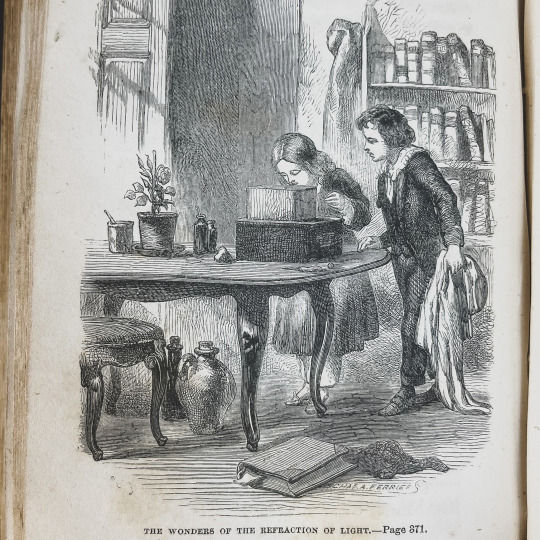
Henry Mayhew’s semi-fictionalized biography (featured here) of a young Humphry Davy uses a narrative of the chemist’s life to teach readers about the scientific properties of two things that are essential to Davy’s famous invention: heat and light. Along the way, Humphry teaches his younger sister, Kitty, about refraction and reflection and how these light phenomena can be used to trick the eye:

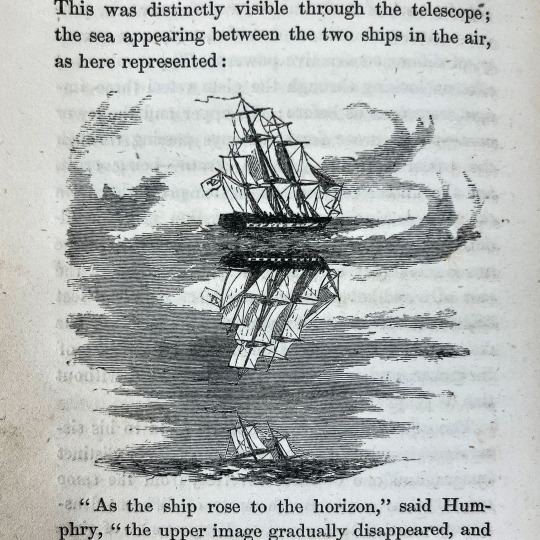
Humphry explains the role that light refraction plays in producing superior mirages. Superior mirages of ships at sea, which make vessels look like they are floating in midair, may be the origin of flying boat legends, such as the Flying Dutchman.

Humphry explains to Kitty the principles of reflection in mirrors.
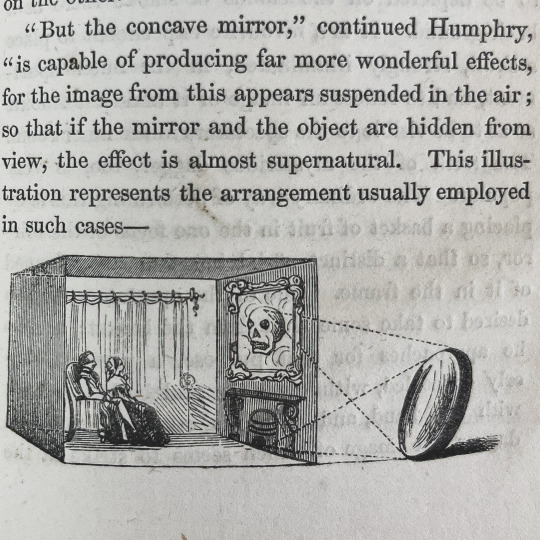
Humphry debunks a popular trick to play on people looking for a paranormal encounter:
“It is a favourite experiment to place a skull, strongly illuminated, in the outer apartment, and to reflect an image of it amid the smoke, so as to be visible to the spectators in the inner room.”
Images from:
Mayhew, Henry. The Wonders of Science, or, Young Humphry Davy. New York: Harper & Brothers, 1856.
Catalog record: https://bit.ly/3Pdk2F7
#international day of light#humphry davy#history of science#rare books#refraction#reflection#optical illusion
40 notes
·
View notes
Text
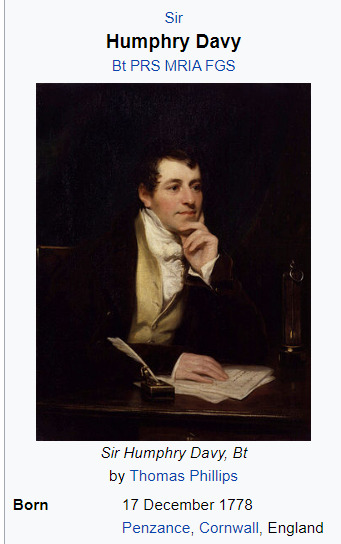
Happy birthday to Humphry Davy! He was a scientist who was the director of the Royal Institution from 1801-1825, with his significant achievements including isolating *deep breath* potassium, sodium, calcium, strontium, barium, magnesium, and boron, all between 1807-1808; more or less inventing the field of electrochemistry; creating the Davy Lamp, which was a very old version of the arc lamp; and discovering nitrous oxide, that is; laughing gas. He was also friends with Samuel Taylor Coleridge and Robert Southey, and edited early editions of William Wordsworth's poems at their request.
#humphry davy#scientific history#fun fact! i wrote this in october while procrastinating on an essay on davy#It Is Queued
7 notes
·
View notes
Text
This guy lived my dream life, writing poetry while making scientific discoveries, oh and training Micheal Faraday cause why not.
#humphry davy#poetry#science#stem#poetry and science#the arts and science#creativity in science#woop woop#micheal faraday#being an icon
1 note
·
View note
Text
We do not know if Mary Shelley met Davy but he was known to her father: he was one of the many who dined at the political philosopher's table.
"Frankenstein's Footsteps: Science, Genetics and Popular Culture" - Jon Turney
0 notes
Photo
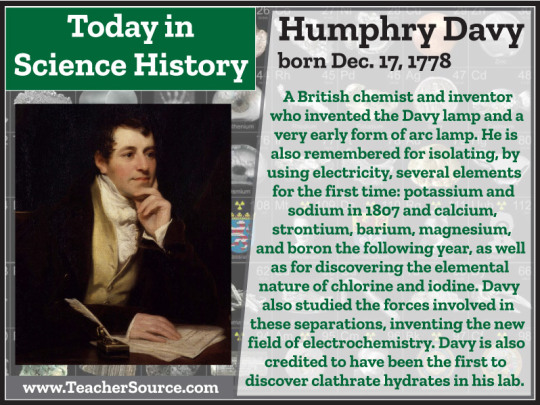
Humphry Davy was born on December 17, 1778. A British chemist and inventor who invented the Davy lamp and a very early form of arc lamp. He is also remembered for isolating, by using electricity, several elements for the first time: potassium and sodium in 1807 and calcium, strontium, barium, magnesium, and boron the following year, as well as for discovering the elemental nature of chlorine and iodine. Davy also studied the forces involved in these separations, inventing the new field of electrochemistry. Davy is also credited to have been the first to discover clathrate hydrates in his lab.
#humphry davy#chemistry#inventors#davy lamp#electrochemistry#discoveries#science#science history#science birthdays#on this day#on this day in science history
0 notes
Photo

#daniel kitson#guy montgomery#tim key#paul williams#david o'doherty#huge davies#steen raskopoulos#ian smith#kai humphries#guy williams#melbourne comedy festival#2023#photo
10 notes
·
View notes
Photo

Page 25: Educate, Hydrate
⏮ First | ⬅️ Older | Newer ➡️ | Newest ⏭ | RSS Link 🔗 | Archive 🐴
Full image description below the cut.
The adventurers descend through a tunnel marbled with minerals. Hans (the eider-duck hunter) is completing his first pillow full of eider-down. “Isn’t it going to become hot as we descend?” Henry asks.
“Aha, but this is science fiction!” the Professor replies.
In the next panel, the Urchin Of Secrecy explains the science that Verne used to justify a cool Earth interior. “Sir Humphry Davy said the Earth couldn’t have a molten core, because the moon would cause constant earthquakes,” the Urchin says. The Urchin wears a mortarboard and uses a ruler to point to a diagram of this theory, where Earth acts like a lava lamp, constantly straining as the liquid core inside it is pulled out of shape by the moon’s gravity.
“This has since been disproved,” Spoiler Fish adds with a laugh.
In the third panel, the Urchin of Secrecy teaches the current known model of the Earth’s interior. “In fact, the mantle is mostly solid, there’s a liquid outer core, and then a solid iron core,” the Urchin explains.
Spoiler Fish adds, “And even though we’re still in the crust, it should be about 500 degrees Fahrenheit!”
In the final panel, we are back in the tunnel with the adventuring party. “Hrm,” Henry says. “I’ll just watch the temperature and keep drinking water.”
“I didn’t pack any water,” the Professor says. “I’m sure we’ll find some.”
“Uncle, I am literally dying here,” Henry replies.
#AdventuresOfStybba#AoS Verne#Stybba#A Journey To The Center of The Earth#Jules Verne#Sir Humphry Davy#putting the science in Science Fiction#have some water
7 notes
·
View notes
Text
ELEMENTLERİN HİKÂYESİ | BÖLÜM 18: “SPEKTRUM, IŞIK VE RENKLER III” (In, I, Cs)
İndiyum, iyot ve sezyum… Bir önceki bölümde de söylediğimiz gibi bu bölümde de isimleri spektrumlarıyla ve renkleriyle doğrudan bağlantılı olan diğer bir 3 elementi konu alıyoruz. Peki, bu bölümde ele alacağımız üç element ne zaman keşfedildi? Bu elementlerin hangi renklerle yahut spektrum analizleriyle ilişkisi vardı? Elementlerimizin keşfi sırasında ne gibi olaylar yaşandı? Elementlerin…

View On WordPress
#bernard courtois iyot#elementlerin hikayesi#ferdinand reich indiyum#gustav kirchhoff sezyum#hieronymous theodor richter indiyum#humphry davy iyot#indiyum#indiyum adı nereden geliyor#indiyum etimoloji#indiyum kaşifi#indiyum keşfi#iyot#iyot adı nereden geliyor#iyot etimoloji#iyot kaşifi#iyot keşfi#joseph louis gay-lussac iyot#robert bunsen sezyum#sezyum#sezyum adı nereden geliyor#sezyum etimoloji#sezyum kaşifi#sezyum keşfi#spektroskopi
0 notes
Photo
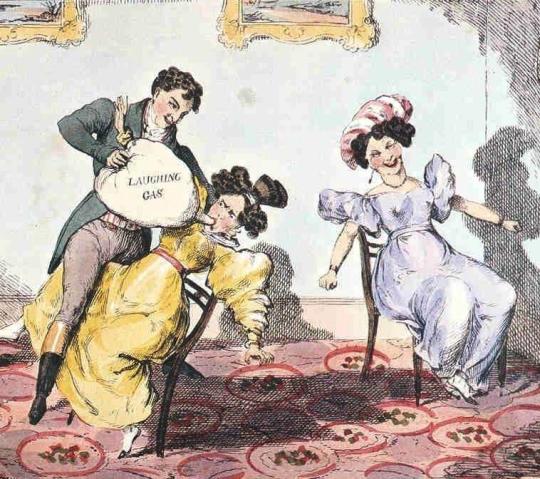
“On April 11th, I made the first inspiration of pure nitrous oxide” — #onthisday in 1799, Humphry Davy became the first to experience #laughinggas (of which he perhaps became a little too fond). Read more in our essay by @MikeJayNet: https://t.co/fT7WoxaCa6 #OTD
77 notes
·
View notes
Text
What’s the secret to a great portrait? At 86 years old, David Hockney has a few ideas. A lifetime of looking has taught him to always start with the face. “I begin with the head first,” he says, matter-of-factly, from his home in France. “From there, I place everything else.”
That was his approach when, late last May, Harry Styles traveled to his light-filled studio in Normandy and stationed himself on a cane chair, ready to become the esteemed artist’s latest subject. Over two days, Hockney worked to capture the exact hues of red and yellow in Styles’s striped cardigan, the indigo of his jeans, the string of pearls at his neck—not to mention the unmistakable tousled fringe of one of the world’s biggest pop stars. For the artist, though, the goal was merely to capture the essence of the person in front of him. “I wasn’t really aware of his celebrity then,” Hockney says, with a shrug. “He was just another person who came to the studio.”
The pair struck up an instant rapport that was likely helped by Styles being a full-on fanboy. For his Vogue cover shoot in 2020, Styles wore a pair of hand-painted Bode cords that featured a talismanic illustration of Hockney by artist Aayushia Khowala. It’s also hard to imagine the wide-eyed wonder of a flamboyant Brit discovering the sunny thrills and spills of California—a theme, and sound, that has permeated the former One Direction singer’s solo albums—without Hockney as a precedent. “David Hockney has been reinventing the way we look at the world for decades,” says Styles. “It was a complete privilege to be painted by him.”
The unveiling of the portrait kicks off the second iteration of the National Portrait Gallery’s Hockney exhibition “Drawing From Life,” which first opened in February 2020, only to close weeks later due to the pandemic. With the addition of a new room of pictures charting Hockney’s creative impulses throughout lockdown, the show returns on November 2—a few months after a refurbishment of the entire museum—with Styles’s portrait as its crown jewel. “The whole world shut down, and the exhibition was still sitting there, in the dark,” recalls Sarah Howgate, the gallery’s senior curator of contemporary collections, who oversaw the exhibition in both phases. “So it’s nice to know it will have another life.”
The Styles painting may bring star wattage, but the unassuming genius of Hockney’s portraiture is still the main exhibition draw. What makes his images tick, you quickly learn, is their honesty: whether in the tension bubbling beneath the surface of his famed double portrait of Ossie Clark and Celia Birtwell, painted between 1970 and ’71, or the seated figures that populated his 2016 Royal Academy of Arts exhibition, which included the likes of his own sister, Margaret, and the late comedian Barry Humphries. Hockney’s eye for the human figure may be playful, often kaleidoscopic, sometimes fantastical—but it’s always, most importantly, frank.
Styles’s portrait will hang alongside those of writer Gregory Evans, Hockney’s printer Maurice Payne, the mayor of his local town Dozulé, his gardener, and even his chiropodist, or in Hockney’s words, “the dandy who cuts my toenails.”
One of his more recent subjects was the eminent music producer Clive Davis, who first suggested inviting Styles to swing by. “Clive told me about Harry’s new album, and JP [Hockney’s studio assistant] sent Harry a note and asked him if he’d like to come to my studio and sit for his portrait,” Hockney remembers. “He replied straight away and said, yes, he’d love to.” From there, Hockney’s process of painting Styles was instinctive. “Everybody just came to sit,” he says, breezily, before admitting: “Now I know Harry’s a celebrity, though: I’ve seen all his music videos.”
“He’s not a traditional portrait painter,” says Howgate. Hockney’s interest is not in what people do, but rather in who they are. “He’s not interested in fame. He’s interested in depicting people and their relationships.” It’s why his eye is primarily trained on his inner circle these days—but it also pays testament to his enduring curiosity that he’s still willing to open that up to a newcomer every so often. Styles seems to know how lucky he is, adding, with a tinge of disbelief: “I’m in awe of the man with enough one-liners for a lifetime.” As to what those one-liners might be? Styles and Hockney’s mutual silence on that question suggests that what happens in the studio, stays in the studio.
“David Hockney: Drawing From Life” will be at the National Portrait Gallery from November 2 to January 21, 2024.
154 notes
·
View notes
Text
When Harry Styles Met David Hockney: An Exclusive First Look At A Special New Portrait
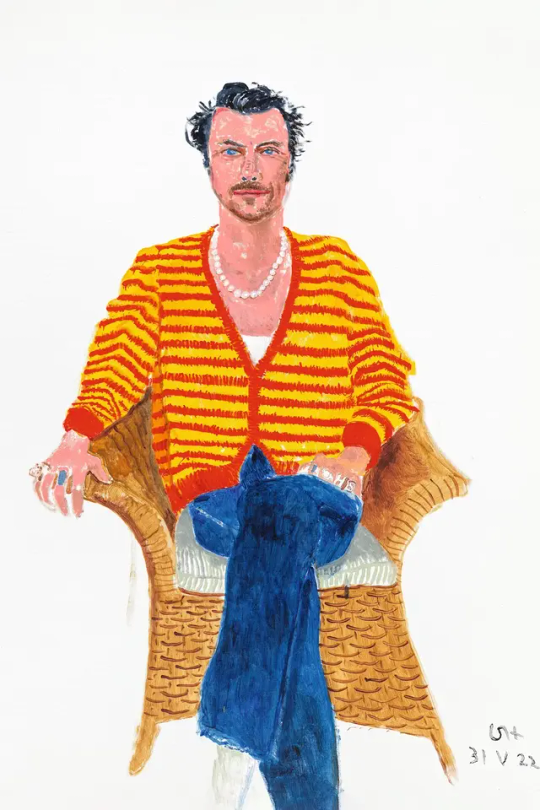
A legendary painter and a pop lodestar? Sparks were inevitable. David Hockney and Harry Styles share a very special sitting with Liam Hess
What’s the secret to a great portrait? At 86 years old, David Hockney has a few ideas. A lifetime of looking has taught him to always start with the face. “I begin with the head first,” he says, matter-of-factly, from his home in France. “From there, I place everything else.”
That was his approach when, late last May, Harry Styles travelled to his light-filled studio in Normandy and stationed himself on a cane chair, ready to become the esteemed artist’s latest subject. Over two days, Hockney worked to capture the exact hues of red and yellow in Styles’s striped cardigan, the indigo of his jeans, the string of pearls at his neck – not to mention the unmistakable tousled fringe of one of the world’s biggest pop stars. For the artist, though, the goal was merely to capture the essence of the person in front of him. “I wasn’t really aware of his celebrity then,” Hockney says, with a shrug. “He was just another person who came to the studio.”
The pair struck up an instant rapport that was likely helped by Styles being a full-on fanboy. For his US Vogue cover shoot in 2020, Styles wore a pair of hand-painted Bode cords that featured a talismanic illustration of Hockney by artist Aayushia Khowala. It’s also hard to imagine the wide-eyed wonder of a flamboyant Brit discovering the sunny thrills and spills of California – a theme, and sound, that has permeated the former One Direction singer’s solo albums – without Hockney as a precedent. “David Hockney has been reinventing the way we look at the world for decades,” says Styles. “It was a complete privilege to be painted by him.”
The unveiling of the portrait kicks off the second iteration of the National Portrait Gallery’s Hockney exhibition Drawing From Life, which first opened in February 2020, only to close weeks later due to the pandemic. With the addition of a new room of pictures charting Hockney’s creative impulses throughout lockdown, the show returns on 2 November – a few months after a refurbishment of the entire museum – with Styles’s portrait as its crown jewel. “The whole world shut down, and the exhibition was still sitting there, in the dark,” recalls Sarah Howgate, the gallery’s senior curator of contemporary collections, who oversaw the exhibition in both phases. “So it’s nice to know it will have another life.”
The Styles painting may bring star wattage, but the unassuming genius of Hockney’s portraiture is still the main exhibition draw. What makes his images tick, you quickly learn, is their honesty: whether in the tension bubbling beneath the surface of his famed double portrait of Ossie Clark and Celia Birtwell, painted between 1970 and ’71, or the seated figures that populated his 2016 Royal Academy of Arts exhibition, which included the likes of his own sister, Margaret, and the late comedian Barry Humphries. Hockney’s eye for the human figure may be playful, often kaleidoscopic, sometimes fantastical – but it’s always, most importantly, frank.
Styles’s portrait will hang alongside those of writer Gregory Evans, Hockney’s printer Maurice Payne, the mayor of his local town Dozulé, his gardener and even his chiropodist, or in Hockney’s words, “the dandy who cuts my toenails” .
One of his more recent subjects was the eminent music producer Clive Davis, who first suggested inviting Styles to swing by. “Clive told me about Harry’s new album, and JP [Hockney’s studio assistant] sent Harry a note and asked him if he’d like to come to my studio and sit for his portrait,” Hockney remembers. “He replied straight away and said, yes, he’d love to.” From there, Hockney’s process of painting Styles was instinctive. “Everybody just came to sit,” he says, breezily, before admitting: “Now I know Harry’s a celebrity, though: I’ve seen all his music videos.”
“He’s not a traditional portrait painter,” says Howgate. Hockney’s interest is not in what people do, but rather in who they are. “He’s not interested in fame. He’s interested in depicting people and their relationships.” It’s why his eye is primarily trained on his inner circle these days – but it also pays testament to his enduring curiosity that he’s still willing to open that up to a newcomer every so often. Styles seems to know how lucky he is, adding, with a tinge of disbelief: “I’m in awe of the man with enough one-liners for a lifetime.” As to what those one-liners might be? Styles and Hockney’s mutual silence on that question suggests that what happens in the studio, stays in the studio.
via vogue.co.uk
133 notes
·
View notes
Text
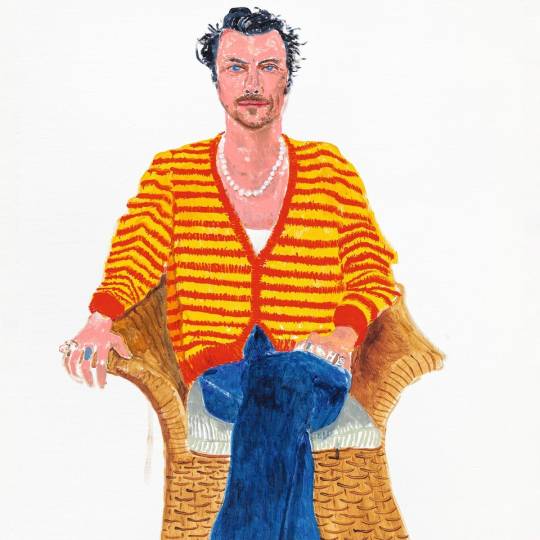
What’s the secret to a great portrait? At 86 years old, David Hockney has a few ideas. A lifetime of looking has taught him to always start with the face. “I begin with the head first,” he says, matter-of-factly, from his home in France. “From there, I place everything else.”
That was his approach when, late last May, Harry Styles travelled to his light-filled studio in Normandy and stationed himself on a cane chair, ready to become the esteemed artist’s latest subject. Over two days, Hockney worked to capture the exact hues of red and yellow in Styles’s striped cardigan, the indigo of his jeans, the string of pearls at his neck – not to mention the unmistakable tousled fringe of one of the world’s biggest pop stars. For the artist, though, the goal was merely to capture the essence of the person in front of him. “I wasn’t really aware of his celebrity then,” Hockney says, with a shrug. “He was just another person who came to the studio.”
The pair struck up an instant rapport that was likely helped by Styles being a full-on fanboy. For his US Vogue cover shoot in 2020, Styles wore a pair of hand-painted Bode cords that featured a talismanic illustration of Hockney by artist Aayushia Khowala. It’s also hard to imagine the wide-eyed wonder of a flamboyant Brit discovering the sunny thrills and spills of California – a theme, and sound, that has permeated the former One Direction singer’s solo albums – without Hockney as a precedent. “David Hockney has been reinventing the way we look at the world for decades,” says Styles. “It was a complete privilege to be painted by him.”
The unveiling of the portrait kicks off the second iteration of the National Portrait Gallery’s Hockney exhibition Drawing From Life, which first opened in February 2020, only to close weeks later due to the pandemic. With the addition of a new room of pictures charting Hockney’s creative impulses throughout lockdown, the show returns on 2 November – a few months after a refurbishment of the entire museum – with Styles’s portrait as its crown jewel. “The whole world shut down, and the exhibition was still sitting there, in the dark,” recalls Sarah Howgate, the gallery’s senior curator of contemporary collections, who oversaw the exhibition in both phases. “So it’s nice to know it will have another life.”
The Styles painting may bring star wattage, but the unassuming genius of Hockney’s portraiture is still the main exhibition draw. What makes his images tick, you quickly learn, is their honesty: whether in the tension bubbling beneath the surface of his famed double portrait of Ossie Clark and Celia Birtwell, painted between 1970 and ’71, or the seated figures that populated his 2016 Royal Academy of Arts exhibition, which included the likes of his own sister, Margaret, and the late comedian Barry Humphries. Hockney’s eye for the human figure may be playful, often kaleidoscopic, sometimes fantastical – but it’s always, most importantly, frank.
Styles’s portrait will hang alongside those of writer Gregory Evans, Hockney’s printer Maurice Payne, the mayor of his local town Dozulé, his gardener and even his chiropodist, or in Hockney’s words, “the dandy who cuts my toenails” .
One of his more recent subjects was the eminent music producer Clive Davis, who first suggested inviting Styles to swing by. “Clive told me about Harry’s new album, and JP [Hockney’s studio assistant] sent Harry a note and asked him if he’d like to come to my studio and sit for his portrait,” Hockney remembers. “He replied straight away and said, yes, he’d love to.” From there, Hockney’s process of painting Styles was instinctive. “Everybody just came to sit,” he says, breezily, before admitting: “Now I know Harry’s a celebrity, though: I’ve seen all his music videos.”
“He’s not a traditional portrait painter,” says Howgate. Hockney’s interest is not in what people do, but rather in who they are. “He’s not interested in fame. He’s interested in depicting people and their relationships.” It’s why his eye is primarily trained on his inner circle these days – but it also pays testament to his enduring curiosity that he’s still willing to open that up to a newcomer every so often. Styles seems to know how lucky he is, adding, with a tinge of disbelief: “I’m in awe of the man with enough one-liners for a lifetime.” As to what those one-liners might be? Styles and Hockney’s mutual silence on that question suggests that what happens in the studio, stays in the studio.
David Hockney: Drawing From Life will be at the National Portrait Gallery from 2 November to 21 January 2024
111 notes
·
View notes
Text

Most academic way of saying "I don't think he actually did any planning for this because this man seems to have made about 85% of his discoveries while screwing around with Michael Faraday in his laboratory using electricity with the aim of making the biggest explosion possible"
3 notes
·
View notes
Photo

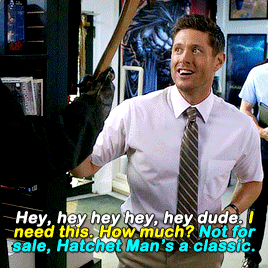



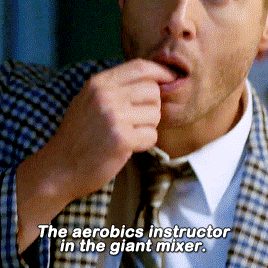


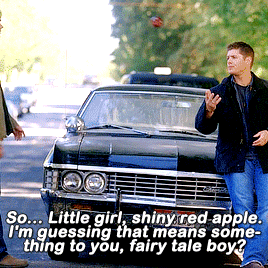

STACKEDextras ➙ You really know your ASD
3.5 Bedtime Stories
Written by Cathryn Humphris
Directed by Mike Rohl
14.4 Mint Condition
Written by Davy Perez
Directed by Amyn Kaderali
Original Air Dates: November 1, 2007 & 2018
#supernatural#dean winchester#sam winchester#deanwinchesteredit#samwinchesteredit#stackednatural#spnedit#supernaturaledit#cowboycoven#spncreatorsdaily#userbbelcher#usersawah#useranny#donestiel#becauseofthebowties#seraphcastiel#userkourt#usermoogs#rambleoncas#tusersana#userdorksinlove#deancaskiss#anztag#userbon#deanncastiel#jennmish#userrlaura#usererinlindslay#oooof another one that took 9000 years#but i wouldntadunit if i didnt think it was a good one. i hope someone else thinks so too sdl;fkglkdfndf
356 notes
·
View notes
Text
John Shiban:
1.06 Skin
1.07 Hook Man
1.11 Scarecrow
1.15 The Benders
1.20 Dead Man's Blood (with Cathryn Humphris)
2.02 Everybody Loves a Clown
2.09 Croatoan
2.15 Tall Tales
2.19 Folsom Prison Blues
Davy Perez:
12.04 American Nightmare
12.12 Stuck in the Middle (With You)
12.15 Somewhere Between Heaven and Hell
13.06 Tombstone
13.11 Breakdown
13.17 The Thing
14.04 Mint Condition
14.11 Damaged Goods
14.16 Don't Go in the Woods (with Nick Vaught)
15.04 Atomic Monsters
15.11 The Gamblers (with Meredith Glynn)
15.15 Gimme Shelter
#supernatural#writers tournament#polls#i like this one because it's like a pvp between old era and new era horror writers
135 notes
·
View notes